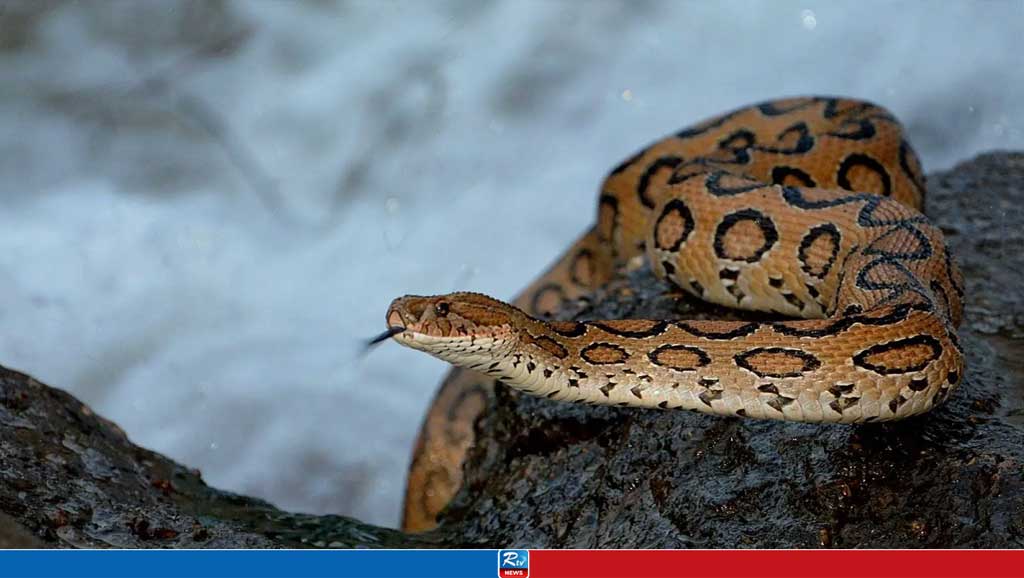Russell's viper (Daboia russelii) is a venomous snake found in Asia. The species is named for Patrick Russell, a Scottish herpetologist who first described many of India's snakes. In Bengali, this snake is called Chandrobora since it carries lenticular or more precisely lunar marks all over its body. Apart from being a member of the big four snakes in India, Russell's viper is also responsible for causing the most snakebite incidents and deaths among all venomous snakes.
Appearance
These snakes are deep yellow, tan, or brown in color, with three series of dark brown spots that run the length of the body. Each of these spots has a black ring around it, the outer border of which is intensified with a rim of white or yellow. The head has a pair of distinct dark patches, one on each temple, together with a pinkish, salmon, or brownish V or X marking that forms an apex towards the snout. Behind the eye is a dark streak, outlined in white, pink, or buff. The venter is white, whitish, yellowish, or pinkish, often with an irregular scattering of dark spots.
Distribution
Geography Continents: Asia
Sub-Continents: East Asia, Southeast Asia, South Asia
Countries: India, Sri Lanka, Bangladesh, Nepal, Myanmar, Thailand, Pakistan, Cambodia, China, Taiwan,
WWF Biomes: Tropical dry forest, Tropical moist forests
Russell's vipers are found in India, Sri Lanka, Bangladesh, Nepal, Myanmar, Thailand, Pakistan, Cambodia, Tibet, China (Guangxi, Guangdong), Taiwan, and Indonesia (Endeh, Flores, east Java, Komodo, and Lomblen Islands). These snakes are not restricted to any particular habitat but do tend to avoid dense forests. They are mostly found in open, grassy, or bushy areas, but may also be found in second-growth forests (scrub jungles), on forested plantations, and on farmland. Russell's vipers are most common in plains, coastal lowlands, and hills of suitable habitat. Humid environments, such as marshes, swamps, and rainforests, are avoided. They are also often found in highly urbanized areas and settlements in the countryside because of the abundance of rodents.
Habits and Lifestyle
Russell's vipers are solitary terrestrial creatures. They are primarily nocturnal foragers. However, during cool weather, they become more active during the day. These snakes like to bask in the sun during the day. The rest time is spent hiding in the caves, in cracks in the soil, or under the leaf litter. Adults move slowly and sluggishly unless they are threatened; after that, they can become very aggressive. Juveniles are generally more nervous in nature. When threatened, Russell's vipers form a series of S-loops, raise the first third of the body, and produce a hiss that is supposedly louder than that of any other snake. When striking from this position, they can exert so much force that even a large individual can lift most of their body off the ground in the process. These snakes are strong and may react violently to being picked up. The bite may be a snap, or they may hang on for many seconds.
Group name: den, nest, pit, bed, knot
Lifestyle: Terrestrial, Precocial, Ovoviviparous, Predator
Seasonal behavior: Not a migrant
Venom
Venom of this species is delivered by means of solenoglyphous dentition. The quantity of venom produced by individual specimens is considerable. Venom yields for adult specimens have been reported as 130-250 mg, 150-250 mg, and 21-268 mg. For 13 juveniles with an average total length of 79 cm (31 in), the venom yield ranged from 8 to 79 mg (mean 45 mg). For most humans, a lethal dose is about 40-70 mg, well within the amount that can be delivered in one bite. In general, the toxicity depends on a combination of five different venom fractions, each of which is less toxic when tested separately. Venom toxicity and bite symptoms in humans vary within different populations and over time.
Diet and Nutrition
Russell's vipers are carnivores. They feed primarily on rodents but will also eat small reptiles, land crabs, scorpions, and other arthropods. Juveniles hunt lizards. As they grow and become adults, they begin to specialize in rodents.
Mating Habits
Russell's vipers are ovoviviparous which means that females give birth to live young. Mating usually occurs early in the year, although pregnant females may be found at any time. The gestation period lasts more than 6 months. Snakelets are produced from May to November, but mostly in June and July. Litters consist of 20-40 young, although fewer offspring may also occur. At birth, snakelets are 215-260 mm (8.5-10.2 in) in total length. They are independent at birth and reach reproductive maturity at around 2-3 years of age.
Population threats
The main threats to Russell's vipers include illegal collection and trade for food and skins. They are also often killed because of fear.
Population number
Presently, Russell's viper is not included in the IUCN Red List and its conservation status has not been evaluated.
Ecological niche
Russell's vipers are often found in settlements in the countryside attracted by rodents, thus playing a useful role in controlling their populations.
Bites of Russell's Viper
Dry bites or bites where only a very small amount of venom is injected may cause slight bleeding, pain, and swelling at the bite injury. If a moderate amount of venom was injected, you are more likely to have severe pain, swelling of the whole limb, and general ill feelings, such as nausea, vomiting, and weakness.
Precautions to Avoid Bites
Protective gear: Wearing rubber boots and gloves while out in snake habitats could prove useful.
Flashlight: Rechargeable torches could help you see better during night time.
Avoid dark corners: Snakes seek out shady or dark places where they can rest and cool down.
Know your snake prone area: Find out more about your local snake species and about the habitats they prefer.
Do not disturb a snake: Snakes do not bother anyone if left alone.
Do not imitate TV shows: Handling snakes takes immense practice and skill, which is not always portrayed on television.
Do's and don'ts after bites
Do's:
Apply a bandage on the bite site covering the bite and the area around it as early as possible. The bandage should not be tight. Avoid unnecessary and sharp movements.
Place a splint while bandaging, to avoid joint movements. Walking or running is not advisable. In case of a bite on the hand, bandage the arm and put in a sling from the shoulder.
Don'ts
Panicking during such times would make matters worse. Do not make any cut, scratch or incision, leave the bite alone. Do not suck the wound, it is a myth and medically not advisable. Do not apply an ice pack to the bitten area. Do not use a tight bandage or tourniquet. Alcohol, herbal medicine or aspirin are not medically-proven antidotes.
Kingdom: Animalia
Phylum: Chordata
Sub-Phylum: Vertebrata
Class: Reptilia
Order: Squamata
Sub-Order: Serpentes
Family: Viperidae
Genus: Daboia
Species: Daboia russelii
Population size: Unknown
Life span: 15 years
Length: 120-166 cm/inch
Source: Animalia Bio
- Dhaka Mon, 27 JANUARY 2025,

 Live Tv
Live Tv













